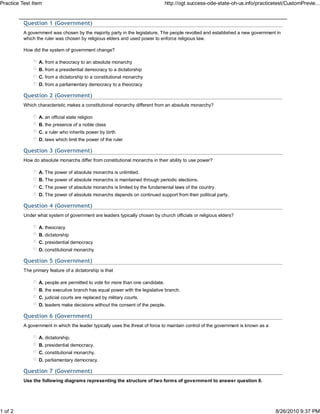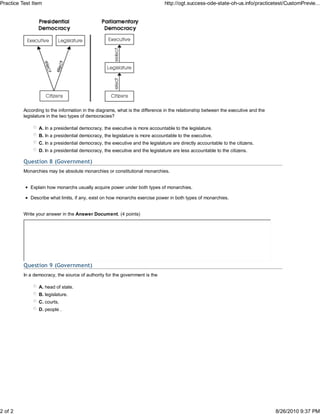Forms of Government Questions
- 1. Practice Test Item http://ogt.success-ode-state-oh-us.info/practicetest/CustomPrevie... Question 1 (Government) A government was chosen by the majority party in the legislature. The people revolted and established a new government in which the ruler was chosen by religious elders and used power to enforce religious law. How did the system of government change? A. from a theocracy to an absolute monarchy B. from a presidential democracy to a dictatorship C. from a dictatorship to a constitutional monarchy D. from a parliamentary democracy to a theocracy Question 2 (Government) Which characteristic makes a constitutional monarchy different from an absolute monarchy? A. an official state religion B. the presence of a noble class C. a ruler who inherits power by birth D. laws which limit the power of the ruler Question 3 (Government) How do absolute monarchs differ from constitutional monarchs in their ability to use power? A. The power of absolute monarchs is unlimited. B. The power of absolute monarchs is maintained through periodic elections. C. The power of absolute monarchs is limited by the fundamental laws of the country. D. The power of absolute monarchs depends on continued support from their political party. Question 4 (Government) Under what system of government are leaders typically chosen by church officials or religious elders? A. theocracy B. dictatorship C. presidential democracy D. constitutional monarchy Question 5 (Government) The primary feature of a dictatorship is that A. people are permitted to vote for more than one candidate. B. the executive branch has equal power with the legislative branch. C. judicial courts are replaced by military courts. D. leaders make decisions without the consent of the people. Question 6 (Government) A government in which the leader typically uses the threat of force to maintain control of the government is known as a A. dictatorship. B. presidential democracy. C. constitutional monarchy. D. parliamentary democracy. Question 7 (Government) Use the following diagrams representing the structure of two forms of government to answer question 8. 1 of 2 8/26/2010 9:37 PM
- 2. Practice Test Item http://ogt.success-ode-state-oh-us.info/practicetest/CustomPrevie... According to the information in the diagrams, what is the difference in the relationship between the executive and the legislature in the two types of democracies? A. In a presidential democracy, the executive is more accountable to the legislature. B. In a presidential democracy, the legislature is more accountable to the executive. C. In a presidential democracy, the executive and the legislature are directly accountable to the citizens. D. In a presidential democracy, the executive and the legislature are less accountable to the citizens. Question 8 (Government) Monarchies may be absolute monarchies or constitutional monarchies. Explain how monarchs usually acquire power under both types of monarchies. Describe what limits, if any, exist on how monarchs exercise power in both types of monarchies. Write your answer in the Answer Document. (4 points) Question 9 (Government) In a democracy, the source of authority for the government is the A. head of state. B. legislature. C. courts. D. people . 2 of 2 8/26/2010 9:37 PM

